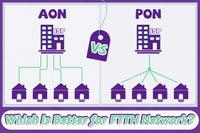Contents
Copper-based LAN (Local Area Network) is a traditional infrastructure that relies on switches, cables, and routers for data transmission and it often requires hardware repairs or replacement with each upgrade. With the rapid pace of cloud computing and AI processing, a traditional copper-based infrastructure can never suffice the development of modern businesses. Therefore, enterprises are seeking a more robust solution that can effectively adapt to modern communication.
Passive optical LAN offers higher bandwidth while enhancing network security and reliability, which ultimately reduces overall operating costs in the long run. Learn about the definition, benefits, and applications of POL or POLAN in this article.
What is Passive Optical LAN?
Passive optical LAN, also known as POL or POLAN, is based on Passive Optical Network (PON) system. A PON delivers data from the center office of an ISP to multiple Optical Network Terminals (ONTs) on users’ ends. Similar to PON system, passive optical LAN employs single-mode fiber cabling and uses a passive optical splitter to distribute information from a central source to multiple destinations. POLAN operates as a point-to-multipoint network, which can serve multiple users at the same time. It uses single-mode fibers for the backbone, linking the main components of a POL architecture. In addition, it uses Wavelength Division Multiplexing (WDM) technology to carry multiple signals over the single fiber, allowing for effective bidirectional transmission.
Main Components of Passive Optical LAN
Besides fiber optic cables, a typical POLAN mainly comprises Optical Line Terminal (OLT), Passive Optical Splitter (POS), and Optical Network Terminal/Unit (ONT/ONU). We’ll explore each of these components in detail in the following content.
Optical Line Terminal (OLT): The OLT is generally located in the building’s data center or main distribution frame. The optical line terminal is connected to the Wide Area Network (WAN) through a core router. The OLT usually integrates the functions of switching, control, VLAN capability, security, and more.
Passive Optical Splitter: A passive optical splitter, as the name implies, works without the need for any power supply. It is used to split and distribute the optical signals from the source device to different termination locations with multiple ONTs. Each passive optical splitter uses Wave Division Multiplexing (WDM) technology for splitting and bidirectional transmission. These splitters can be placed in telecom closets or ceiling fiber zone boxes, which are often near to user’s ends..
Optical Network Terminal/Unit (ONT/ONU): The ONT/ONU is typically located at the user’s premises and is used to connect end devices, such as computers and laptops. It is a terminal device that provides photoelectric conversion. During upstream transmission, the ONT converts the electrical signals into optical signals, while in downstream transmission, it reverses the process by converting optical signals to electrical signals for end devices. ONTs are available with 2 to 24 ports, and feature many other service ports like Ethernet ports, CATV RF ports, USB ports, and VoIP ports.
Advantages of Passive Optical LAN
The next section will explore the advantages of passive optical LAN, highlighting why it is becoming the preferred choice for modern network infrastructure.
Cost Efficiency
Passive optical LANs reduce the need for numerous rack units, communication closets, switches, and cables, which can help save budget. In addition, POLAN doesn’t require power at the splitter level, reducing power consumption. The use of fiber optic cables allows passive optical LAN to support long transmission distances between the central offices to the user’s end, eliminating the need for expensive repeaters and intermediate devices. Though fiber optic cables may have a higher initial cost than traditional copper cables, the overall cost of POLAN is lower.
Scalability
As modern digital technologies develop and business evolves, the network requires change or upgrade. POLAN can offer exceptional scalability. On the one hand, POLAN allows for easy network expansion by adding additional optical network terminals. On the other hand, POLAN can support high bandwidth and fast data transmission. Fiber optic cables remain to have superior performance. So POLAN supports future growth in bandwidth and speed needs driven by IoT, smart automation, and artificial intelligence.
Space- and Energy-saving
Reduction in floor or room space is quite important for organizations looking to optimize their facilities. As mentioned earlier, POLAN works by splitting optical signals and since the optical splitter doesn’t require any power supply, it reduces the need for both power and cooling in the central office.
High Performance and Reliability
POLAN provides a fast data transmission speed with low latency and minimal signal loss. Unlike traditional copper cabling, POLAN centralizes the entire network infrastructure, allowing network and IT technicians to maintain and troubleshoot issues in a single room. POLAN can provide higher reliability by equipment redundancy and route diversity in fiber optic cabling, ensuring continuous service and performance.
Improved Security
Passive optical LAN also provides enhanced security. Optical fibers are resistant to crosstalk, Electromagnetic Interference (EMI), and Radio Frequency Interference (RFI). In addition, optical LAN only has one IP address for hundreds or thousands of Ethernet ports, and ONT in POLAN doesn’t require IP address management, which can greatly reduce the attack surface. With centralized management and maintenance, POLAN minimizes the need for extensive human intervention, further enhancing security.
Applications of Passive Optical LAN
Passive optical LAN has been widely used in different scenarios, such as enterprises and campuses. Here are some common applications:
- Different Fields: Passive optical LANs are widely used in different high-density fields. In large enterprises, passive optical LAN provides fast and secure internet connections, ensuring seamless productivity. In campus networks, POLAN allows students from different departments to share a common network; In hotel industries, POLAN can optimize space utilization and energy efficiency.
- Versatile Services: Passive optical LANs are well-suited for many applications such as HD TV and video on demand, wireless access, security and surveillance systems, smart building, and online gaming.
Passive Optical LAN vs. Traditional LAN
Different features of passive optical LAN and traditional copper LAN make each suitable for different application. So, how do you choose the right one for your needs?
Traditional copper LAN is often a great choice for small-scale networks like home or small business network with lower user density. While reliable for short-distance applications, it may have limited performance in extra long-distance and data-heavy applications.
POLAN can be the best choice for many scenarios thanks to its scalability and superior performance. For example, it is often used in high-density and high-demand environments like large-scale enterprises and campus where large number of devices need to be connected for high-speed network speed. POLAN is suitable for data-intensive addition, and well-suited for installations over long distances.

If a copper LAN is already deployed in your existing network infrastructure, and meet your current needs, a quick upgrade to POLAN may not be necessary. But if you’re planning for future business and network expansion, POLAN provides a more future-proofing solution.
In the future, the combination of POLAN , IoT (Internet of Things), and cloud business can change the lives of individuals and businesses.
|
Comparison |
Traditional Copper LAN |
Passive Optical LAN |
|
Main Architecture |
Copper Wiring |
Single-mode Fiber Cabling |
|
Cost |
Higher |
Lower in long term |
|
Space Occupation |
More |
Less |
|
Performance |
With Limited Performance Over Long Distances |
Supports High Bandwidth Over Long Distances |
|
Future Scalability |
Limited by Network Infrastructure |
More Adaptable to Future IoT, AI, and other applications |
Final Thoughts
For modern enterprises, passive optical LAN has become increasingly vital. It provides a flexible way for enterprises to expand bandwidth capacity while saving IT infrastructure space. Fiber cabling enhances network reliability and security, contributing to the long life cycle of POLAN. Choosing a traditional copper LAN or POLAN depends on your specific needs, but POLAN can be more future-proofing.
For more information on this topic, you can keep up on our blogs. While VCELINK offers general and basic information for our customers and other visitors to the website, it’s not professional advice.



Be the first one to comment.
Leave a comment